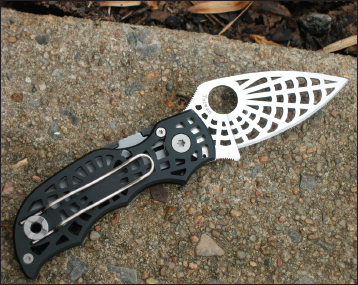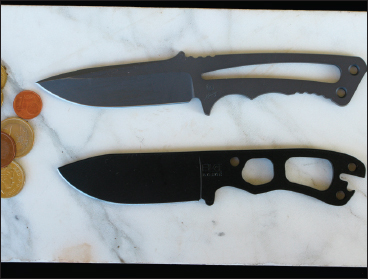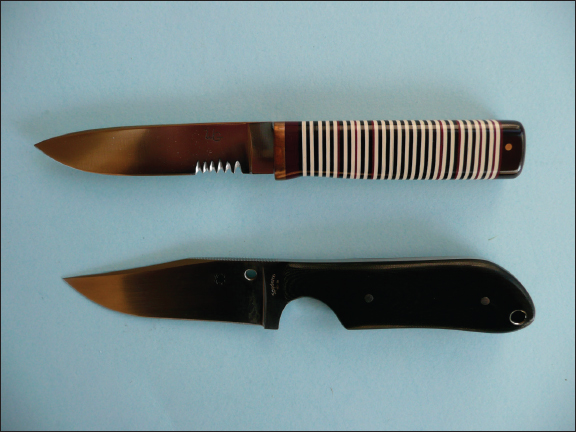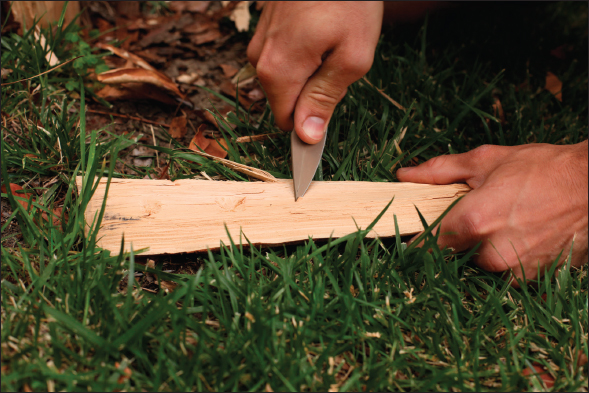
Chapter 19
Tiny Tacticals
The term tiny tactical is a term I created to describe a category of knives that I do not think has been adequately recognized. The fixed blades in this category are often called neck knives, which tells us nothing about them except the intended method of carry. The folders are not called much of anything, expect whatever individual name the maker assigns to them. As a class, I know of no name that describes a little folder with a blade of two inches or less and has tactical potential. I believe that both small folders and fixed knives are worthy of attention and should be considered on their own terms. First, let’s take a look at the folders.
Tiny Tactical Folders
It’s generally agreed that a tactical folder is a folding knife with features that make it tactical: a reliable blade lock, strong construction, exceptional cutting ability, one-hand opening, and a clip to attach it to your clothing. Most tactical folders have blades of about four inches or, in smaller versions, blades of about three inches. A tiny tactical has a blade of no more than two inches.

A collection of tiny tacticals, both folders and fixed blades.
This category may seem a bit overly specific, but there is a considerable difference between the social acceptability of a folder with a two-inch blade and one with a four-inch blade. Like it or not, we must deal with issues of social acceptability. Also, there are many places, more and more these days, where we are not legally allowed to carry a knife any larger than what amounts to a penknife. Moreover, a tiny tactical is much more useful than any penknife. In order to qualify as a tiny tactical, the knife must meet the same criteria as the large tactical, folder, except for its size.
How useful is such a small blade? Very. Our ancestors survived and thrived with such small blades as a starting point, so to speak. As an amateur student of archaeology, I have learned that stone age hunting and gathering cultures got along quite well with tiny stone knives with an average length of about two inches. Ötze the Iceman, who was discovered in the Alps in 1991, was found with a flint knife of just this size. From his possessions it is clear to scholars that he made his bow, arrows, and other tools with his two-inch flint knife.
Jürgen Weiner, a friend who is a respected archaeologist and recognized authority on lithic, or stone, tools consulted on the Iceman excavation. Jürgen tells me that Neolithic hunters relied on small blades for most of their work. They made stone axes for chopping down trees and other heavy work. But for day-to-day skinning, game processing, wood crafting, and other basic tasks, they relied on short (at least by our standards) stone blades. They also killed each other with them, as has been proven by the examination of hundreds of fossilized skeletons. In addition, they used their small blades to make larger tools, such as bows, spears, baskets, and the other stuff of everyday life. In other words, Ötze’s gear was the standard Neolithic outfit for a hunter–warrior.
Over many millennia, our ancestors learned what worked best, and those little blades were it. They could, and did, make larger blades, but those were used mostly for ceremonial purposes or to impress the neighbors—Neolithic conspicuous consumption. We may not have to wrest a living from the wilderness, but we can learn something from our ancestors. If they could build an entire culture with such small blades, and if they decided that such a small blade was the best tool for most jobs, maybe we should consider that our modern tiny tactical folders might be the right tools to take care of many daily tasks. They can also help us get out of a tight spot when needed.
I have dressed out game with a Spyderco Dragonfly, a tiny folder with a two-inch blade. Recently my son tied his Spyderco Cricket onto a long bamboo pole and cut a ripe orange from an out-of-reach tree branch for one of the neighborhood children. My wife uses her Cricket daily to open boxes, trim threads from garments, and a hundred other tasks, including slicing a baguette. Often she uses her tiny folder to prepare dinner in spite of having a kitchen full of knives. And trust me, our kitchen is full of knives.

Spyderco Cricket and Dragonfly.

Spyderco S knife.
I have used the plain-edged Dragonfly to plane the flats on a quickie bow, much as I would have used a flint planer. I’ve also used the Cricket to make notches for arrows and dig out a spindle holder for a bow and drill fire set. Jürgen Weiner and Jim Riggs, another expert in lithic arts, instructed me in the technique of using stone tools. I simply substituted the Dragonfly to try it out. It worked great, as it did for other primitive craftwork and most anything else.
These homely tasks show the utility of the short blade, even for wilderness survival. But what about a real world survival situation in a city? What use would such a small blade be in an extreme situation, say a high-rise fire—something that only sounds unlikely until you find yourself in a burning building?
Think of the two-inch blade of a tiny tactical as the tip of a larger tactical folder. Most blade work gets done with the first couple of inches anyway. If your tiny folder meets the tiny tactical criteria, it can cut a fire shield from a carpet or baton through a stuck door almost as well as its larger cousins. With proper technique you can do some amazing things with a tiny blade. A tiny tactical is not just any small folder. To meet the standard, it must be strong. It must have a solid reliable lock. It must take a razor-sharp edge. A clip is so useful, it amounts to a necessity, particularly in the case of these little guys. Clipped to a waistband, with the clip behind a belt, your miniature folder is all but invisible. Attached to a sock, sleeve, or undergarment, it becomes part of your clothing.
There is much to be said for a serrated edge on a tiny tactical. Harking back to our ancestors, all stone blades are serrated. The serrations on a stone blade have a lot to do with their exceptional utility. Stone blades are made by flaking off tiny chips until a sharp edge forms. The result is an edge that cuts more aggressively than a plain edge of the same overall size. Serrations are not required for a tiny tactical, but they do ratchet up its overall effectiveness, albeit at the loss of the ability to do fine woodcarving. But everything is a trade off. I use both.
Spyderco has been the pioneer in developing this category of knife. Their Dragonfly and Cricket define the category and are available is a variety of finishes and handle materials. We have used both models extensively over the past years and have found them unexpectedly useful. ML, my ever-resourceful wife, snatched the first Cricket she saw before it was even out of the box. That was some years ago and she hasn’t been without one since. At present, she uses her pretty little engraved Cricket for everything. However, do not get the idea that the Cricket is useless for anything but domestic chores. It has a wicked little recurved blade and point and is capable of doing serious damage in a self-defense situation.
I used to teach seminars on self-defense with edged weapons. I actually preferred using tiny tacticals for these particular classes. My intent was to teach defense, not offense, and little knives are effective for that purpose. In addition, their appearance is inoffensive and no one objects to carrying them. Some are so small as to be unnoticeable until needed.
Some years ago, Spyderco cataloged the Co-Pilot, back when you could still carry a small knife onto an airplane. I bought a half-dozen Co-Pilots and distributed them to students in a class I taught back then for certain people who needed a means of emergency defense in restricted areas. I wish Spyderco would bring back all their little folders—I think they had two or three other similar models—and offer them as a series: Tiny Tacticals.

Spyderco collection of tiny tacticals: Dragonfly Lightweight, SS Dragonfly, SS Cricket, Etched Cricket, and the SS Spin Etched.
Now other companies are making tiny tactical folders. Al Mar’s SLB (Stout-Little-Backup) seems to qualify. Kershaw’s Ken Onion Chive and Small Eros, as well as some models from CRKT look like good candidates. Check out the current factory catalogs. You’ll probably find quite a few tiny tactical folders, even though they won’t be listed by that category.
When you find one you think will serve, try it out in the kitchen. Kitchen usage is a true test of utility. Then, if you value preparedness, test it for extreme usage. Perhaps baton it through an old door, or cut up a piece of sheet metal. Use some common sense and caution while doing these things. Don’t slip and cut yourself. Don’t do these things at all if you are not sure you can handle a knife safely.
If you wreck the knife while dressing out an old Honda, do not complain to the maker. Do not ask for a refund. It is your responsibility to test your gear, and no manufacturer should be expected to bear the cost for that. The destruction of a folder is a small price to pay for the security of knowing the limits of your equipment. After you are satisfied that your choice will serve your needs, buy a few of them. These are not expensive knives. I consider my Dragonflys and Crickets to be all-time bargains. I use them daily and am not afraid to use them up if need be.
Tiny Tactical Fixed Blades
You can hang any knife around your neck and call it a neck knife. A butter knife on a string might be a neck knife, but it sure isn’t a tiny tactical. There are two main differences between a tiny tactical fixed blade and a folder: one, it doesn’t fold and is therefore stronger, and two, it’s a little larger because . . . right, it doesn’t fold. In order for a fixed blade to be considered a tiny tactical, it must be tough; it must take an excellent edge; and it must be small, with no more than a three-inch blade and about six inches overall length.
Many folks wear Moras around their necks, and they’re certainly sharp and reasonably strong. However, Moras run to blade lengths of about four inches, overall about eight inches, which puts them into another category and size range. So by these standards, Moras aren’t tiny tacticals.
These knives do include: the Buck/Mayo Kaala, the Becker Necker, the Chris Reeve Professional Soldier (a little oversized for this category, but it’s close), the ESEE Izula, the Spyderco Fred Perrin Street Beat, Fred Perrin’s Neck Bowie, and the Spartan Blades Enyo. There are others, but these are the ones I have recently reviewed. All of these tiny tacticals are tough. All come sharp and stay that way, are well designed, and are easy to carry. Basically, these knives define the category of tiny tactical fixed blades. You can do anything with these knives that you can do with the folders and more, including prying, twisting, tearing, ripping, and stabbing—all things you want to be careful about when using a folder.

ESEE Izula with arrow quiver from Borneo.

Chris Reeve Professional Soldier and the Becker Necker.

Wayne Goddard LBK and Spyderco’s Fred Perrin—two fixed blade tiny tacticals.

Spartan Blades Enyo making a fireboard.
They vary a good bit one from one another. The Reeve is made of S35V steel, as is the Enyo. The Becker and the RAT are 1095. Of course, each maker has his or her own heat treat, so steel choice isn’t definitive. The Becker and the RAT are both flat ground. The Buck is deeply hollow ground. The Reeve has a sophisticated combination of grinds. They are all in the same size and weight range. Check out the reviews in the makers’ sections for details on these terrific little blades. In general, they’re all good to go.
With its fine finish, nicely contoured handle, and polished VG-10 blade, the Spyderco Fred Perrin Street Beat is the class act in this crowd. The blade is a little longer at three inches, and it straddles the category between tiny tacticals and traveler’s knives. We’ve used this one hard and extensively, and it has performed way out of its class. So has Perrin’s smaller but just as useful Neck Bowie. See Spyderco in the review section for more information on the Street Beat and Fred’s section for more info on the Neck Bowie.
Either one of the folders or the fixed blades would make an excellent back up to a bigger blade. Or they can stand on their own. As small as they are, you could easily carry both a folder and a fixed blade or more than one of each. One of my correspondents, a contractor who worked the past few years in hot, dry places where lots of bad guys blow things up and kidnap people, carries two Spyderco Crickets clipped to his underwear. This is in addition to his primary shoulder weapon, a handgun, a hideout pistol, a large fixed blade, and a tactical folder. He told me, “You will not be seeing me on the Internet being beheaded.”
On a lighter note, anyone with a modicum of skill and a healthy dose of determination could wander off into the wilderness and survive, in fact thrive, with only tiny tacticals. Our ancestors did for hundreds of thousands of years.